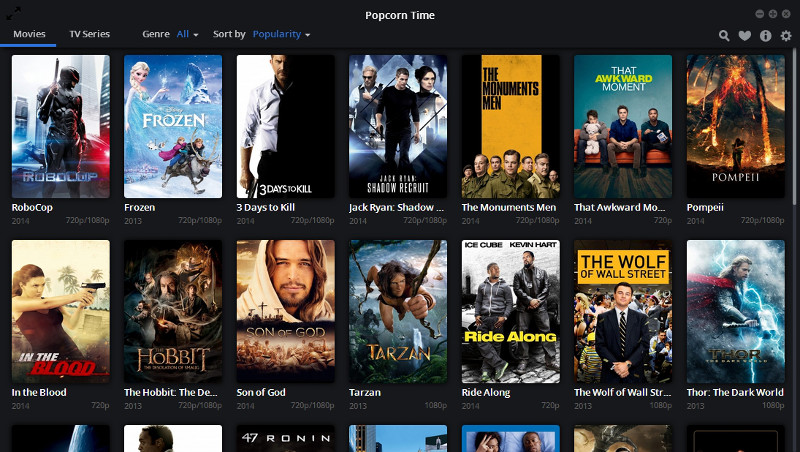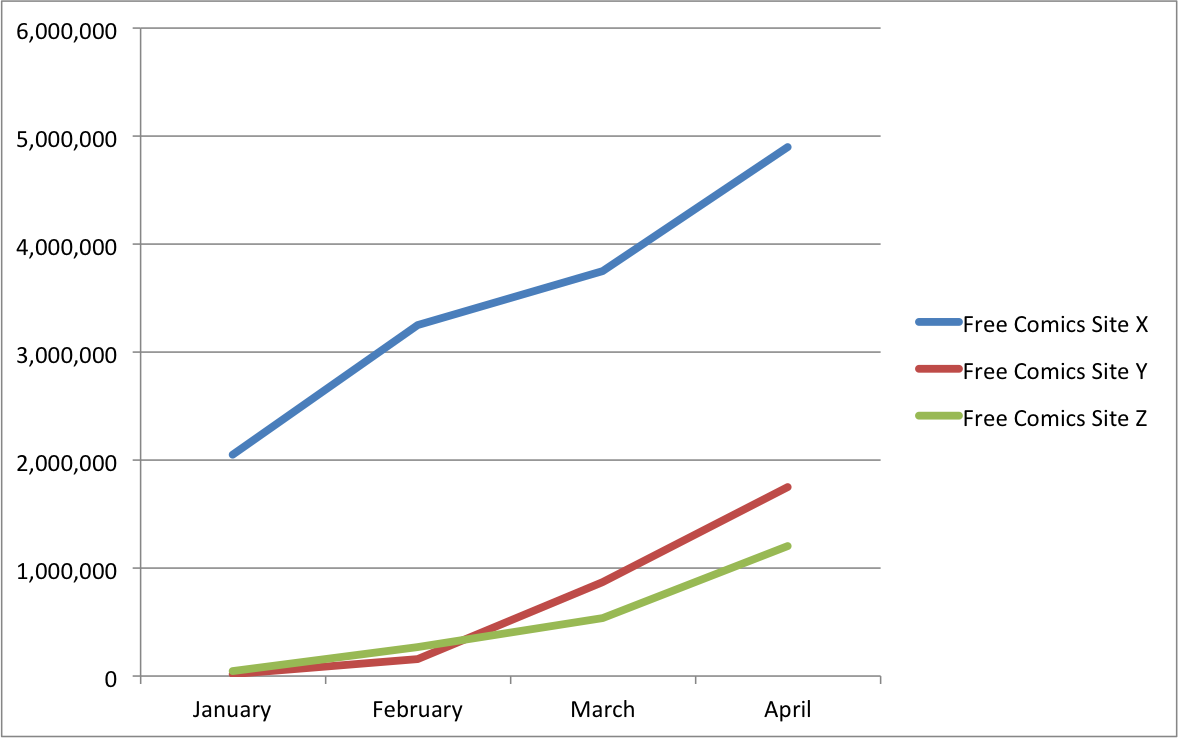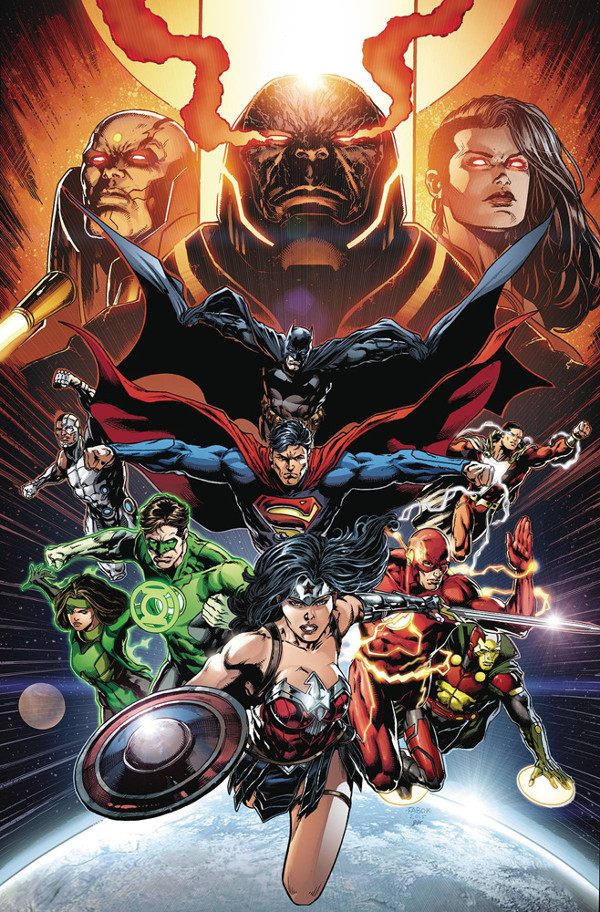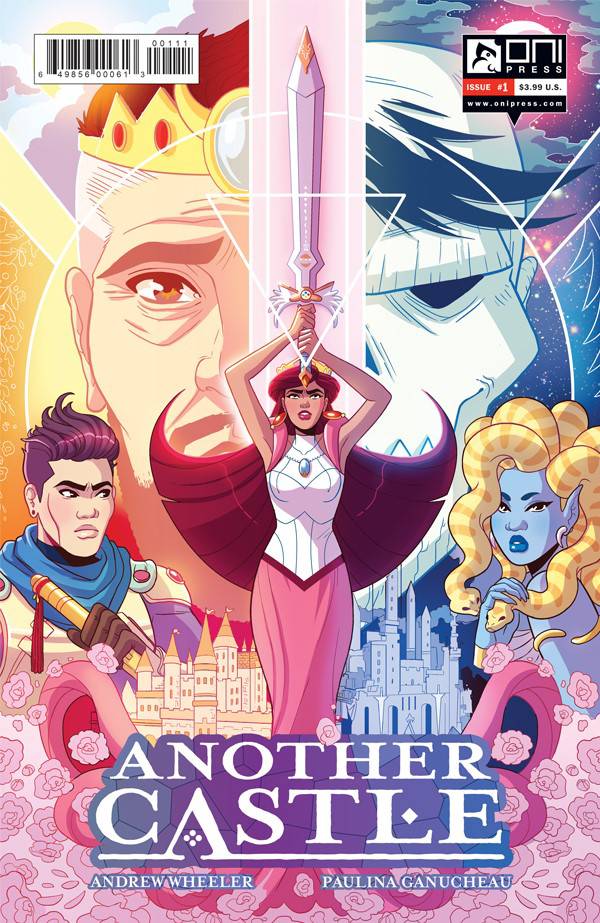Money for Nothing: A Look at the Popularity and Questionable Legality of Free Comic Sites
I used to hate Lars Ulrich.
In April of the year 2000, the Metallica drummer and his band sued peer-to-peer file sharing service Napster and in the process triggered its downfall. As a 16-year-old Alaskan music aficionado who remembers the first song he ever downloaded off the service – Outkast’s “B.O.B. (Bombs over Baghdad)” – it was a heartbreaking event. How would I stay on top of the music world on an allowance and the pittance earned in paychecks from a local comic and sports cards shop – especially given that I was converting that into comics and cards almost immediately? The struggle was real.
Back then the Internet was a tumultuous, unpredictable place, even compared to now. Juveniles like myself finding their way on this chaos engine was not unlike when notable historical figures such as Beethoven, Genghis Khan and Joan of Arc were brought to a modern shopping mall by Bill and Ted: it all went to hell. No one had any idea what they were doing. You just went with what felt right, like Napoleon did when unleashed at a water park named Waterloo.
Now? I’m 32 years old, and I see the folly in my ways. These days, the Internet has become a more organized – if still uncivilized – place. I don’t pirate anything anymore because, honestly, the music, movie and TV show experience through Spotify, iTunes and Tivo is easier than the alternative. And while cost is a driver for many who pirate, ease of use might be an even bigger one.
Comic books have never had a piracy crisis on the level of Napster. As a medium, it’s far more immutable than music, its adoption hasn’t been as widespread, and it hasn’t had any services enter the zeitgeist in the same way. That isn’t to say piracy isn’t a thing. Far from it. Torrents have long proved a potent resource for the industrious comic reader. Many other options have buoyed them as well. The options are there. They just haven’t had the same impact. There are a number of reasons for that, but frankly, the biggest is illegally downloading comics can be an ordeal.
While illegally downloading music or movies is straightforward – download and press play, really – pirating comics can be a slow, frustrating process for those unfamiliar. It can require you to download additional software and can bog down your computer down with unfriendly viruses. In short, ease of use has never been on the side of illegal comic outlets, and as mentioned before, simplicity can be a major selling point. Comics have always lacked a user experience like the discontinued Popcorn Time, a BitTorrent client that acts as an alternative to Netflix, making the process of watching illegally downloaded movies quick and painless. Select, download, repeat – it’s that easy. That dearth of an illegal comic platform with a simple user experience put an artificial ceiling on its impact.

Until now, that is. Recently, three sites – which will go unnamed for a couple reasons found at the end of this article – arrived to the scene, changing the game for comics. It was only a matter of time until someone found a solution to reading comics online for free in a quick, clean and easy way, and this trio did it. With the advent of these sites, the comic industry may be dealing with a much greater piracy issue than ever before. While these are likely neither the first nor the last sites to pull off this type of endeavor, as of now, they’re the biggest games in town. And it’s easy to see why.
All three have easy to use reading interfaces and quickly load the week’s comics on site. A large amount of last week’s comics – from big name titles to small – were loaded the day of release. Not only that, but their libraries are comprehensive, pulling in independent comics and larger publishers alike, delivering complete runs for books like Saga and The Walking Dead at the click of a button. Just the existence of these sites is a major problem. That they’re enormously popular compounds the issue.
Site Statistics per SimilarWeb
| Site | Visitors | Page Views/Visit | Time on Site | SimilarWeb Rank |
| Free Comics Site X | 4,900,000 | 36.5 | 18:34 | 2,957 |
| Free Comics Site Y | 1,750,000 | 42.27 | 20:51 | 7,886 |
| Free Comics Site Z | 1,200,000 | 25.35 | 19:11 | 16,623 |
| ComicBookResources.com | 11,200,000 | 2.72 | 5:51 | 4,465 |
| Marvel.com | 9,100,000 | 3.02 | 2:28 | 5,483 |
| BleedingCool.com | 3,100,000 | 2.14 | 2:14 | 19,037 |
Above you can see data for the three free comic sites as well as three popular comic related websites (all data estimated by SimilarWeb, a web traffic and analytics service). This data is for April 2016 and includes visitors (total people who visit the site), page views per visit, time on site, and where SimilarWeb ranks them amongst all websites (based off a formula derived from the previous three statistics, amongst others). The reason the three legitimate sites are included is to provide context. We all know how popular Bleeding Cool is, right? It’s part of the daily comic conversation. All three of these free comic sites are rated higher than it on SimilarWeb. The most popular of the three is even ranked higher than Comic Book Resources and Marvel.com.
That’s because these sites aren’t just getting a lot of visitors – and they are, with all three generating over 1.2 million visitors in April – they’re getting incredible depth to their visits as well. The average person on the lowest rated of the three viewed at least 25 pages in April – which makes sense as each page of a comic counts as a page view – and stayed on site for 18 and a half minutes. That’s incredible. Those are the kinds of numbers most websites would kill for, both in volume and in on-site experience. That’s not the scariest part, though. The most alarming part is they’re growing, and quickly at that.

Site X is the graybeard of the group (per WhoIs, its domain was created in January of 2015), but it still more than doubled in visits since this January. The other two are wee babies comparatively, barely being gleams in their creator’s eyes when the year turned (Site Y’s domain was created in October 2015 while Site Z was in December 2015). Yet in their limited lifespans, they’ve become enormously popular already and they’re trending up in a major way.

So these sites are big and they’re growing, but what does that mean for the comics themselves? Is there any way to measure the impact they have on the prospects of comics both big and small? Not really, or at least not in any real, attributable way. One of the tricky things about the piracy of entertainment is it’s nearly impossible to say what the financial impact could be if sites like these didn’t exist. It’s even more complicated with comics, as the ordering process means any data we get isn’t reflective of true consumer behavior for several months. Anything we say would be estimated from the information we have, which is very little on a per comic basis. But we do have a bit, so let’s look at that.
Before doing so, it’s worth noting that, for the most part, Marvel and DC dominate on all three sites. When you look at the most popular lists, they’re littered with the usual suspects. Deadpool, Spider-Man, Justice League, Batman, Injustice are amongst the most read titles. That’s to be expected. Regardless of the medium, what’s popular in the piracy realm tends to mirror what leads the way in the actual sales.
Only one site shares how many views each comic gets – Site Y – and it’s uncertain whether the views they’re referring to are page or comic views. But for our purposes, we’re making the assumption that the number refers to total comic views. And while digging into Marvel and DC books could be interesting – after all, they are the dominant force on these sites – instead, we’re going to focus on creator-owned projects. Given the nature of these books, the impact could be felt more directly by more people. Beyond that, the margins are tighter with these titles. To me, that additional weight makes their numbers more interesting in this situation. Here’s what was found from a small, random selection of creator-owned comics:
Free Comics Site Y Per Comic Views Since October
| Title | Views |
| The Walking Dead | 924,003 |
| Saga | 54,406 |
| Rat Queens | 24,491 |
| Chew | 15,224 |
| Sex Criminals | 14,472 |
| Lumberjanes | 8,887 |
| Revival | 7,886 |
| Deadly Class | 7,285 |
| Giant Days | 6,322 |
| Shutter | 3,719 |
| The Bunker | 2,966 |
| Another Castle | 1,958 |
Remember when I said Marvel and DC led the way? I meant besides The Walking Dead, which dominated the Most Popular charts on these sites. While we know some of the hordes of TV show fans have made their way over to the comics, we can see that many of them are finding other, more inexpensive avenues to read the title through as well. The numbers are still in the thousands even for more recent, lesser known books like Another Castle from writer Andrew Wheeler, artist Paulina Ganucheau and publisher Oni Press. That’s significant when the first issue was only estimated to have orders of a little over four times that amount.

Again, these numbers don’t represent sales lost. These are sales left unrealized due to other avenues presenting themselves, and again, given the nature of the comic ordering system, it’s safe to assume the people who use these sites aren’t the pre-ordering type. But if we’re talking theoretical value and label a view as a read of an issue, when you multiply the list’s numbers by cover price you have over $500,000 in potential revenue left unrealized even without The Walking Dead factored in. That’s just one of the three sites, and not even the biggest one. Site Y only had 35% the traffic of Site X in April. We’re talking about a lot of comics being read and not purchased, potentially contributing to less copies being ordered by shops when physical copies gather dust.
While I know that this could lead to greater sales elsewhere in the sales chain – writer Jim Zub found that Skullkickers sales picked up after he started to serialize it online for free – the choice to do so should be up to the creators or publishers, not illegal comic sites.
And that’s an important note to make: these sites are illegal. While all of them make attempts to cover themselves legally, using concepts like “fair use” and the Digital Millennium Copyright Act (DMCA) as wards, there’s little legal about them. Those defenses are probably nonsense, as Intellectual Property attorney Ira Domnitz noted to me.
“Websites that believe that a mere citation to ‘fair use’ can protect them from copyright infringement are mistaken as there are numerous factors that Courts use for any ‘fair use’ analysis in determining infringement,” Domnitz said. “Generally, if a website actively posts materials in violation of copyright, trademark or indeed any other laws, a broad legal disclaimer will not waive potential liability.”
“Incorrect citation to laws is not a ‘shield’ to any liability for violating a law.”
Fair use has long been a nebulous and debatable concept when it comes to defense of suspicious use of trademarked and copyright materials, and with good reason. It can be difficult to diagnose, as Walter Richardson, a student at George Mason School of Law and my former cohort at Multiversity Comics, noted.
“It is true that what is and isn’t fair use can be hard to pin down, and there are times where whether or not something is fair use could really go either way,” Richardson said. “It is also true that these sites are undoubtedly, 100%, not at all an example of fair use.”
“The noncommercial purpose is one of many factors that comes into play when deciding whether or not something qualifies as fair use. It is absolutely not a required element for copyright infringement, as some seem to believe. Every single other factor of fair use weighs heavily against these sites: there is nothing transformative about their use of the comic, they use the entire comic from cover to cover, the work is fictional and thus subject to higher standards of fair use, and this is a direct substitute for buying the comic (people can and do argue about that last factor over and over, but I’m just saying what a judge would say).”
As for Site X and its theoretical protection through the DMCA, that’s even thinner. As Richardson noted, that only only affords protection to one’s own original copyrighted works, and “from a cursory glance their site appears to have pretty much nothing that would count as ‘original’ besides maybe the banner.”
For comic creators and publishers, there are a bevy of legal options at their disposal. There’s the classic cease and desist, a letter from a lawyer that can be used to effectively say, “you are violating our copyright, stop or we will bring suit,” per Richardson. “It’s essentially a bluff, but usually a bluff no one wants to call.”
And if the site ignores the cease and desist letter, willful infringement will be that much easier to prove. That means intent, which means higher damages, which leads to unhappy illegal comic sites. When these sites ignore the cease and desist letter, Domnitz shared the best option is going after them for trademark infringement (presuming the creation or some elements of it are trademarked) instead of copyright infringement.

“Trademarks generally protect identification of source of goods or services. Take Batman for example. Most artists are really not making a direct copy of a Batman drawing, rather they are making use of the trademark character to entice people to purchase their products. In other words they are making money on the Batman identifier,” Domnitz said. “Hence, it is really a trademark violation in regards to use of a well recognized mark, owned by DC, to generate business for a third party. It is called passing off, false designation of goods, or dilution of a mark.”
“Trademark allows you to effectively stop others from using characters (with exceptions) versus copyright which is relegated to individual artistic works.”
The biggest problem for publishers and creators – and having reached out to several, some are aware of the problem – is these sites are owned and operated by phantoms. All three were registered outside of the United States and are unreachable through any available contact options (as I found out). And beyond that, those most affected are the ones that can least afford the time and money it takes to resolve such an issue. These kinds of lawsuits are expensive. There’s a reason it took the combined Metallica and Dr. Dre to take down Napster. What’s a small comic publisher or creator to do beyond a cease and desist letter?
It’s a tough nut to crack, especially considering these kinds of illegal activities aren’t going anywhere. While I wised up over the years, there’s still an enormous market for this kind of thing. It’s a part of life for all forms of entertainment, and it assuredly can and does impact the success and life cycle of many beloved creations. That’s the case whether you make movies, TV shows, music, books or comics.
But in the comic industry, where many smaller books and creators are riding the razor’s edge between success and failure, this can be a killer. These sites impact comics in the long tail, and that’s where books often need the most help. After all, number one is an easy sell compared to number eleven. Sites like these can contribute to titles ending prematurely, writers and artists struggling to make ends meet, retailers being left with excess stock and publishers facing tough times. How much it does is uncertain, but it can’t help.
One hope is comics move in the direction music did eventually. Napster went away, to be replaced eventually by paid models like iTunes and Spotify. That helped legitimize digital music. Are options like that the solution in comics as well? Maybe, although we already have an iTunes comp in the form of ComiXology, and clearly plenty of people enjoy the fruits of the labor these comic pirates put in.
Who knows what the future holds for sites like these and what their continued impact to comics will be. It’s impossible to tell really. One would hope the 800 pound gorillas of the comic world – we’re talking Marvel and DC – sic their parent company driven legal teams after them, nipping this issue in the bud in the process. That could happen or be happening already behind the scenes. Only time will tell. All I know is looking into this made me realize something finally: maybe Lars Ulrich wasn’t completely wrong after all.
Header images are from the covers to The Walking Dead #1 (art by Tony Moore), Another Castle #1 (art by Paulina Ganucheau), Deadpool #1 (art by Tony Moore) and Saga #1 (art by Fiona Staples). Thanks to Ira Domnitz and Walter Richardson for the legal insight. Domnitz will be making two panel presentations on the intersection of comics and legal issues at this year’s Comicpalooza in Houston in June – if you’re in the area, don’t miss them. Also, a few quick notes:
1. The illegal comic sites were left unnamed within for two reasons: one, I don’t want everyone to go and read them, and two, by linking you, I could be held liable as a contributory infringer if this ever went to court. I’d prefer to avoid that. If you’re a comic creator or publisher and would like to know the names of these sites, feel free to email me.
2. After this article went final, Site X’s domain was seized. I like to think it was related to some of the work I was doing, but as of now, the reason for it is uncertain. As of publication, Site Y and Site Z are still operational.
